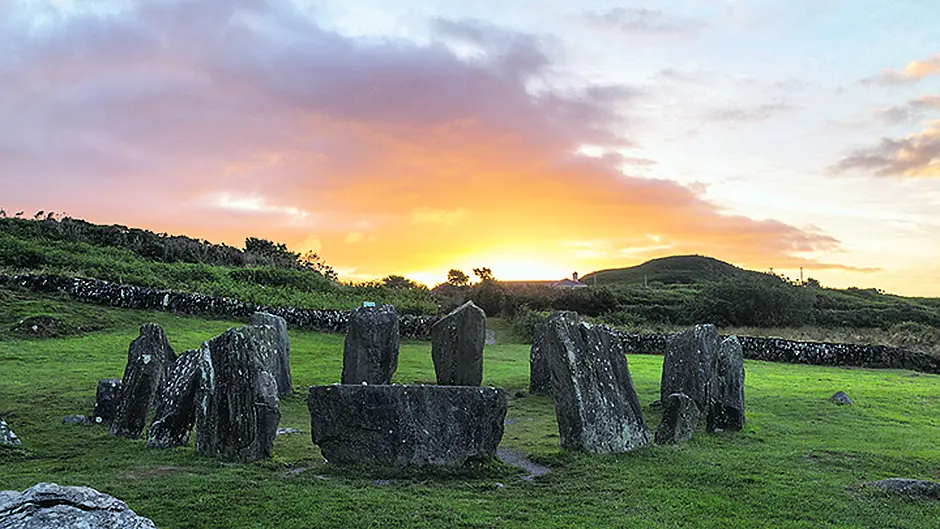From the tallest Ogham stone in the world, to ancient wedge tombs, and hut sites, West Cork has a wealth of ancient history, says David Forsythe
From the tallest Ogham stone in the world, to ancient wedge tombs, and hut sites, West Cork has a wealth of ancient history, says David Forsythe
TAKE a walk almost anywhere in West Cork, and you are bound to come across a relic of the past.
The countryside abounds with ruins, notable and not so notable. Castles, abbeys, towers, old shacks, cottages, physical memories that cling to the landscape. Perhaps the most intriguing of these many reminders are the megaliths, literally meaning ‘great stones’.
West Cork is among the best places in the world to discover these ancient monuments, with hundreds of them dotting the landscape from Beara to Bandon. Impressive stone circles and wedge tombs stand within just a few miles of solitary standing stones that are hardly noticed. Whichever way you look, you are never far from the handiwork of West Cork’s first builders.
These stones fascinate us because they are unknowable. There is no written history, we don’t know why these monuments were built and we never can for sure. All we can do is wonder and speculate and be amazed at what our forebears were able to achieve thousands of years ago. The sheer number of megaliths in West Cork is astonishing, as Beara-based local historian Fachtna O’Donovan points out.
‘On the Beara Peninsula alone, there are more than 500 sites,’ he says, ‘many identified by the late Connie Murphy.’
He says you will spot them in gardens and fields, behind hedges – ‘They are everywhere if you know what you are looking for.’
Beara’s wild and rugged landscape is a suitably dramatic location for megaliths and Fachtna says there are a number of very impressive examples within walking distance of Castletownbere itself.
The Derreenataggart stone circle is less than two miles from town if you follow the road past the Olde Bakery.
‘This is a very impressive stone circle,’ says Fachtna. ‘The name means the “Priest’s Little Wood”. There are 12 stones and the circle is aligned with the equinox and there are lovely views back over the bay.’
Derreenataggart is a recumbent circle, meaning that one of the stones was laid on its side as a sort of altar in the arrangement. Originally, there were thought to be 15 stones, but only nine remain standing and three are missing.
If you are feeling more adventurous, you could head to the wedge tomb at Cloontreem, high above the town. This requires a little more effort if you are walking, but the spectacular views are worth it. Take the road behind the Millbrook Bar, take the first left turn and follow the track until you reach the end. Following the Beara Way on foot for another mile or so, you find the tomb overlooking the bay and offering an amazing view.
This is a wedge tomb, much like the more famous example at Toormore known as ‘The Altar’ but this example has seen the capstone dislodged.
‘It’s a very interesting site,’ explains Facthna. ‘There are hut sites and enclosures and ancient field walls, as well as the tomb, and the view is spectacular.’
Back at sea level, another Beara gem Fachtna recommends is the Ogham stone at Ballycrovane. Located just north of Eyeries at Faunkill-in-the-Woods, this is the tallest known Ogham stone in the world, standing 17ft tall and overlooking the Atlantic.
‘It’s a real message from the past,’ says Fachtna. ‘There are names on the stone. It may be honouring ancestors, or it may mark graves or territorial boundaries – we just don’t know.’
Heading east another hotspot for megaliths can be found around Bantry and is perhaps the most underrated site in all of West Cork. The Kealkil Bronze Age complex is a particular favourite of archaeologist Áine Brosnan, both for its location and variety of structures that survive. It’s located above the village following the road past the church – turn right and then left. ‘This is a very spectacular site,’ says Áine. ‘You have three in one here with a stone circle, a radial stone cairn and two very large standing stones that were probably part of a stone row originally. And you also have fantastic views, almost 360 degrees as you look down on the Beara and Mizen peninsulas. It’s well worth the effort of seeking out.’
There are several other impressive sites in the area, including the Breeny More stone circle that’s just a few hundred yards away to the south and nearby in Coomlha, the Mill Little stone circle is also easy to access, follow the Priest’s Leap road for half a mile, turn left and then right.
Further east again and we come to perhaps the best-known of all the megalithic sites in West Cork, the Drombeg stone circle, which is located in a picturesque coastal location between Rosscarbery and Glandore. This is one of the easiest sites to access and is one of the best examples of a recumbent stone circle in Ireland.
Ronan Murray, originally from the USA, has been researching the Drombeg site for 20 years and published two editions of a book on the subject Secrets of Drombeg. He is convinced that Drombeg is actually part of a larger complex with two other lesser-known stone circles nearby, Reenascreena and Bohonagh. Both of these are large, impressive circles that are virtually intact.
Ronan says the three sites form an almost perfect equilateral triangle. His theories based on extensive research suggest that the builders of these monuments were influenced by techniques developed in ancient Bablyon. Reenascreena is hard to access, being across several fields but Bohonagh, is close to the main N71 just east of Rosscarbery.
Many stone circles are aligned to the stars, the sun and the moon, and most researchers agree that they probably served multiple purposes – astronomical, ceremonial, social and funereal.
‘The people that built these knew what they were doing,’ says Ronan. ‘They are specifically designed. The importance of numbers in the construction is astonishing.’
He believes that Reenascreena, Drombeg and Bohonagh represent birth, life and death respectively, each being designed in a particular way and alignment, in relation to the others.
Áine sees the stone circles as equivalent to today’s cathedrals. ‘They must surely have been central to their communities. If you think of that time there would have been nothing else like them. They would have been extraordinary, like a cathedral today.’
Áine Brosnan will be leading a tour of the Kealkil stone circle organised by the Bantry Historical and Archaeological Society during the Taste of West Cork festival in September. Check with the society for details closer to the date.









